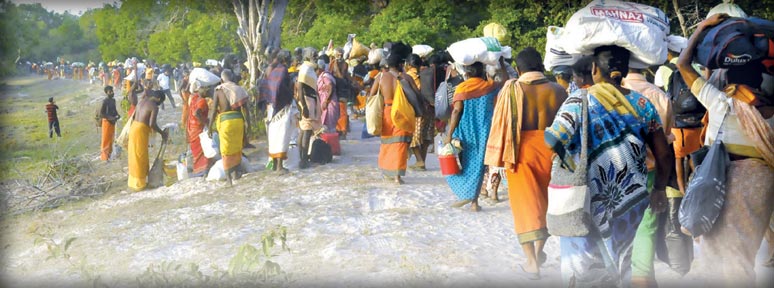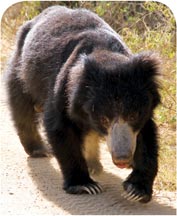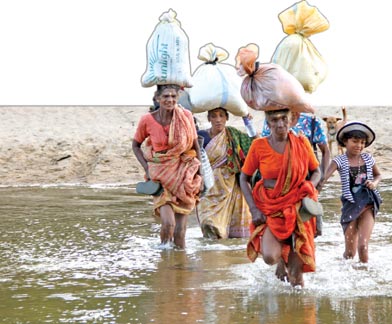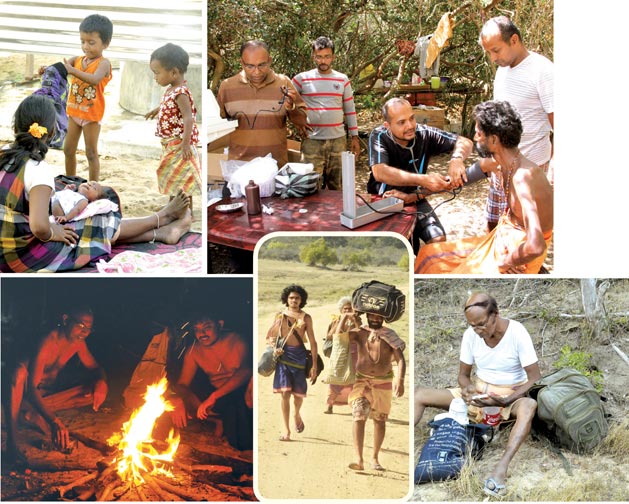 The
long walk to Kataragama The
long walk to Kataragama
On a quest to capture the essence
of an ancient tradition, Sunday Observer photographer Susantha
Wijegunasekara joins the Pada Yatra in Okanda and makes the
four-day-trek to Kataragama, living the wayfarer life and sharing a bond
that is unique among pilgrims. This is his experience in words and
pictures
I began my journey on July 5, setting off from Colombo around mid
morning. I was accompanied by my colleague Chatura. We reached Arugam
Bay at around 3.30 p.m. Rather than cart everything from Colombo we
decided to get the necessary provisions from Arugam Bay. Having packed
the essentials, our next plan of action was to make our way to the
Okanda Devale through Panama. This was the starting point for the walk
that would take the pilgrims to Kataragama.
We were lucky to get a lift to the Okanda Devale on a rambling
tractor that had the trademark Kohomba leaf decoration, indicating that
was on some kind of spiritual journey. Turns out, the tractor was on its
way to Okanda Devale, with a load of pilgrims from Akkaraipattu, on a
mission to clean the Kataragama Devale before the Perahera commences.
Rumbling along we reached Okanda late at night. With not much else to
do, we set up our tent, deciding to have a good night’s rest to prepare
for the arduous days ahead.
Dawn in Okanda, as the sun makes its lazy way up, is a breathtaking
experience. It was also the wakeup call for the pilgrims. Many could be
seen bathing in the huge pond in front of the Okanda Devale. Many
believe the water in the pond has curative powers, and that bathing in
it would cure them of various ailments.
  Conversation
is not easy in the early hours, as all are busy, packing their meagre
belonging and getting themselves spiritually psyched for the next step
of the journey, the long walk to the Kataragama Devale. Many were
offering Poojas, some were singing Bajans. And all too soon, we set off
accompanied by the chanting of “Haro Hara” in varied tones. It was
barely 6.00 in the morning. Conversation
is not easy in the early hours, as all are busy, packing their meagre
belonging and getting themselves spiritually psyched for the next step
of the journey, the long walk to the Kataragama Devale. Many were
offering Poojas, some were singing Bajans. And all too soon, we set off
accompanied by the chanting of “Haro Hara” in varied tones. It was
barely 6.00 in the morning.
Kumbukkan Oya
Our journey, done with varying degrees of intensity, speed and
devotion brought us to Kumbukkan Oya. We had by then travelled nearly 20
kilometres. Walking with us was Sujan, who hails from Ampara. An ardent
devotee of the Kataragama Deviyo, he said he was making the pilgrimage
to secure the blessings of the Kataragama Deviyo for his family and
relatives.
Traditionally the P?da Y?tra starts from Jaffna peninsula, usually
the Nallur Kovil. Devotees take as long as two months to reach
Kataragama, travelling through Kumana National Park on their way. It is
an arduous journey and pilgrims depend on the hospitality of strangers,
accepting alms, walking barefoot and sleeping in temples or under the
open sky.
More than 2,000 pilgrims set off from the Kumana National Park on
this segment of the Y?tra. The Wildlife Conservation Department provided
us with cloth bags and urging us to refrain from taking polythene bags
to the Park as it can cause harm to the environment. A breakfast of
‘kiri bath’ was provided by the Sri Lankan Army.
The pace was steady as we walked through Kumana National Park towards
Kataragama, passing through many villages including Linthuna, Warahana
and Katagamuwa, enjoying the sights and sounds that only nature can
conjure.
And though it should come as a complete, heart stopping, mind
stumbling surprise to come across two bears cavorting in the open, we
take it in our stride, stopping to enjoy their antics. Reality strikes
as the brief stop turns into a 20-minute stay, and we realize what a
rare opportunity it is, to see the ferocious creatures up close and
carefree.
 As
we continue with our walk, reality of how arduous this journey is begins
to set in. Our bags that weigh nearly 40 kilograms are beginning to get
heavy. Our feet begin to ache, thirst is a constant companion and the
body begins to tire. Stopping is not an option, so we trudge alone. As
we continue with our walk, reality of how arduous this journey is begins
to set in. Our bags that weigh nearly 40 kilograms are beginning to get
heavy. Our feet begin to ache, thirst is a constant companion and the
body begins to tire. Stopping is not an option, so we trudge alone.
Weary pilgrim
The army, turning out to be a true friend of the wayfarer, has set up
temporary water tanks at strategic points on the dry paths of Kumana.
This was indeed a god send, for thirst, it was turning out is a constant
companion of the weary pilgrim.
Later, around 11.30 we called a halt to the walk, to begin preparing
for lunch. We collected firewood and made a makeshift hearth, using
elephant and buffalo dung as props as we could not find stones. We
boiled the carrots, beans and cabbages we brought from home and ate them
with a sambol we made with onions, green chillies, pepper and salt. We
rested for a while after having lunch, but all too soon, we were on our
way.
We started walking towards the Kudakabaliththa Devale, which was
still within the confines of the Kumana Park.
It was quite disheartening that only around 200 of the 2000 pilgrims,
who set off the Okanda Devale, continued on the journey with us. Others
choosing to make it to Kataragama in time for the perahera, at their own
pace and route of choice.
We set up camp at the Kudakabaliththa Devale and spent the night
there, enjoying a soothing cup of plain tea before calling it a day.
 It
was indeed a long, tiring day. But the night sounds of elephants and
bears in the jungle, crocodiles catching fish in the lake kept us awake
well past midnight, as the mosquitoes and sundry other small insects. It
was indeed a long, tiring day. But the night sounds of elephants and
bears in the jungle, crocodiles catching fish in the lake kept us awake
well past midnight, as the mosquitoes and sundry other small insects.
Early next morning we left the Kudakabaliththa Devale and slowly made
our way to Linthuna Devale, covering a distance of 26 kilometres. The
path was a little dangerous as there were wild buffaloes everywhere.
From Linthuna we set off towards Katagamuwa in Yala, spending the
night there before setting off towards the Kataragama Devale.
Kanda Kumaraya
Steeped in legend and lore, the walk from Okanda to Kataragama has a
beautiful history. Legend has it that Kanda Kumaraya also known as God
Skanda, shortly after landing on the shore of Okanda, went to Kataragama
and brought Valli Amma with him when he returned. Today the place where
the Kanda Kumaraya landed has a rock in the shape of a boat. Both of
them are said to have walked from Kataragama to Okanda.
Today, both Valli Amma and Kanda Kumaraya are worshipped as God and
Goddess not only by Hindus but by all the other religions as well. Each
religion claims Kataragama as its own.
This is perhaps the appeal of Kataragama, which transcends
territorial boundaries. Each worshipper considers himself privileged in
his belief believing that he gets the blessings of Kanda Kumaraya and
Valli Amma. All feel really good when the pilgrimage is concluded and
return home, buoyed by lightness that lifts the spirits.
The Perahera begins on the first day of July and sees the Basnayaka
Nilame of the Ruhunu Maha Kataragama Devale, joining it from the 6th
day. For the first 14 days, the Perahera proceeds from the Maha Devale
to the Valli Amma Devale and back along the main street to the Maha
Devale again. The final Perahera on the night of July 15 proceeds from
the Maha Devale to the Kiri Vehera, then back to the Valli Amma Devale
and from to the Maha Devale.
Duty demanded that we forego the Perahera in Kataragama and return to
Colombo. We returned, tired after the five-day trek, but in high
spirits, understanding somewhat the appeal of the long, long walk that
sees people from all walks of life and from all parts of the country,
giving up the comfort of their homes and easy lifestyles, to rough it
out for two months, to bask in the glory of being blessed.

- Written by Husna Inayathullah
|

